Stories We Missed: The Year AI Art Went Mainstream
Despite a banner year for AI art with the release of DALL-E 2 and MidJourney, the fruitlessness of its endeavour has become plain
Despite a banner year for AI art with the release of DALL-E 2 and MidJourney, the fruitlessness of its endeavour has become plain

When the pandemic lockdowns started, I predicted bad things for art. Stuck in quarantine, the art commentariat flocked to every digital craze under the sun. The screen beckoned: online exhibitions, the Metaverse, Web 3.0. What else were we going to talk about but pixels and bits? After all, digital utopians thrive on institutional collapse. ‘Art as we know it will be fundamentally disrupted by blockchain’, was a common refrain. Crypto geeks rejoiced and Ponzi schemes proliferated. Remember NFTs? I’d rather not.

Art was just emerging from its crypto winter in the spring of 2022 when artificial intelligence stole the show. Art made with semi-autonomous machines has been around since the 1960s, when engineer A. Michael Noll coaxed an IBM 7090 to produce ‘patterns’ at Bell Labs, but its recent prominence has been impossible to ignore. Six years after the arrival of neural network art – a computing method, popularized by Google’s Deep Dream, that mimics the functionality of the human brain – 2022 was the year AI art finally went mainstream. AI researchers advanced tools like Generative Adversarial Networks (GANs), which made deepfake videos like Barack Obama’s 2018 public service announcement possible, and released text-to-image tools that turned simple prompts into fantastic images. We also saw an upgrade to DALL-E 2 and the release of Midjourney. OpenAI’s forthcoming GPT–4 chat bot is anticipated to take one of the biggest leaps in machine learning when it is released next year.
All of these represented significant progress toward a consumer-ready artificial general intelligence. Likewise, a new crop of artists have grown more deft in their applications of GANs, as AI art made some of the most significant forays into art’s institutional confines to date. For ‘Unsupervised’ (2020–2023), artist Refik Anadol used AI to transform more than 200 years of art at MoMA into a generative AI data painting installed in the museum’s lobby; and Ai-Da, an ultra-realistic humanoid robot artist, presented ‘Leaping into the Metaverse’, a solo exhibition of machine-generated art at the Venice Biennale.
AI art has come so far it’s hard to remember that in the beginning it wasn’t meant to be art at all. When neural network image classification research was reverse engineered, it stumbled on to ‘art’. The first years were focused on proving that machines could do something visually interesting, but there was little reflection on why they should or who might care. Nobody really asked for AI art, but it was deemed innovative, and so here we are.

It hasn't taken long for astute observers to point out the limitations of AI art. To wit, MidJourney is interesting for about 25 minutes. After that the shine wears off and the fruitlessness of the endeavour becomes plain. It’s amusing in the same way that listening to someone else describe their dreams is amusing - which is to say, not at all.
To be sure, there are commercial applications. Low level illustrations for businesses, for instance, or those times one needs a photorealistic rendition of Danny DeVito as a Gregorian monk and is pressed for time. Nevertheless, AI art is presently stuck in a middle period where the outputs are rudimentary exercises in stylistic mimicry. As for the future, these so-called ‘creative’ machines are limited in that they can only ever remix existing media and data, they cannot truly create anything new. This is the province of human ingenuity alone.

Two possible futures await us as ‘creative’ tasks become increasingly automated. In one, AI does the drudge work of the culture industry; no more painters paying the bills as commercial illustrators. This may, counterintuitively, bring renewed reverence for the role of the artist now that they alone can free us from the remix pabulum churned out by the latest software update. We won’t get to this fully-automated culture industry immediately, however. During a transition period, judgments of taste will be messy.
No matter how impressive an AI artwork appears, it must reach the viewer through a highly-choreographed performance of accreditation by socially-sanctioned authorities. Today the institution of art begins and ends with the presence of the human author, a construct AI art will pressure us to reassess. This may lead to a second, more dire, future. What if fully-automated cultural production is all audiences ever really wanted, and the distinction between human creativity and machine-generated culture disappears through popular indifference?

The most likely scenario stands somewhere in the middle. Human artists will use various AI technologies as one or more steps to enrich their practice, just like they might use any other tool. In either case, an entirely new set of institutions must rise to account for this new authorial paradox.
AI art is, categorically, a terminus. Not a breakthrough but a facile end. Its results are a mile wide but an inch deep. But it is nonetheless an exciting development in our utilitarian present, where cultural work is measured by its ability to fulfill a set of basic requirements; can it fool a judge? Can it sell? Is the museum audience fascinated? We’re living in the most exciting times for the least exciting people.
‘The Year AI Art Finally Went Mainstream' is part of a series of short essays on the events and trends we missed in our coverage of art and culture in 2022. Read more – and last year’s stories – here
Thumbnail: A human reaches for a robotic hand. Photo: Tara Winstead






















